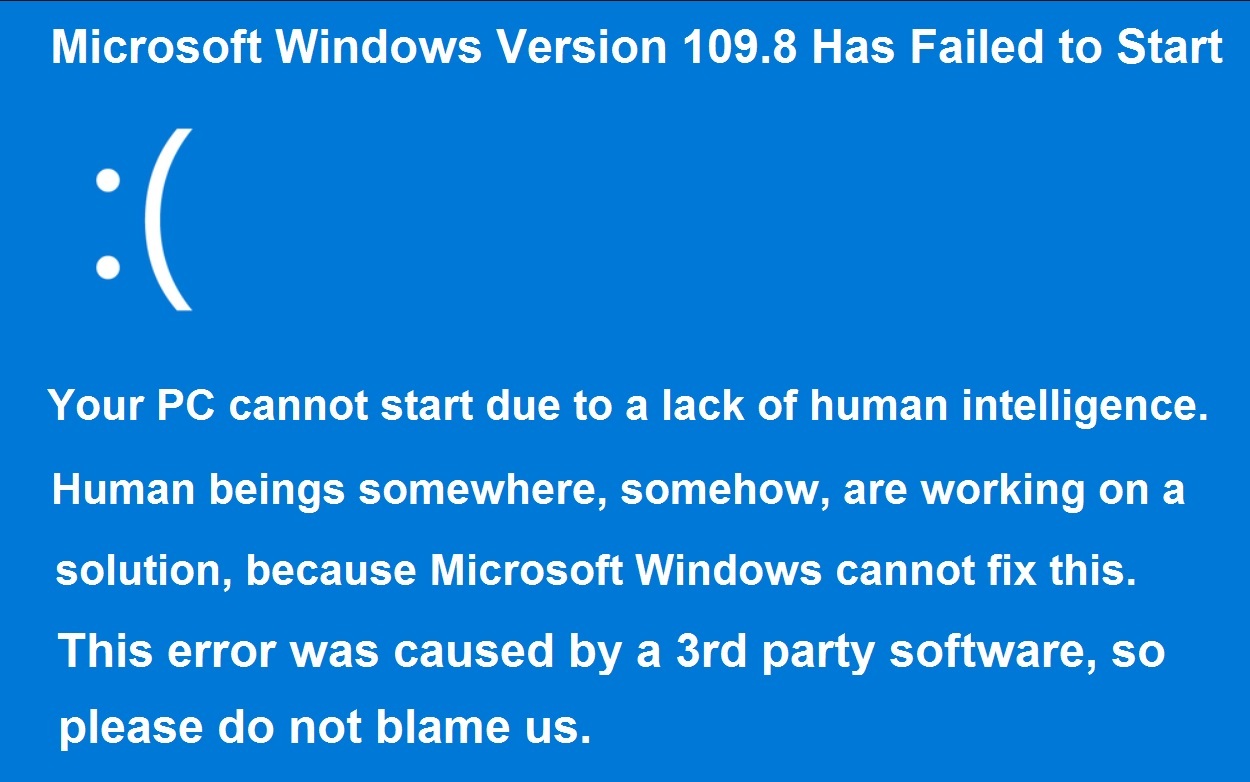
by Brian Shilhavy
Editor, Health Impact News
This past Friday morning brought headlines such as “Largest IT Outage in History!” and “Just Like Y2K Except this Time it is Real!”
Hundred of millions, if not billions, of people and businesses around the world were affected, from airlines to FedEx and other delivery companies to financial institutions to hotel reservations and personal PC users.
The culprit was reported as a Microsoft Windows update to a software program that runs on many Windows computers, from the cybersecurity firm CrowdStrike.
Microsoft has reported that the glitch affected 8.5 million devices.
First, let me address the numerous rumors online in the alternative media that this was a deliberate event to delete all the data surrounding the Trump shooting. Here is a typical comment I saw:
We all missed it. Crowstrike intentionally put out malicious code, where the solution is to roll back to a previous system restore point. All recent data is lost covering the days surrounding the attempted assassination.
A lot of digital breadcrumbs were lost. On purpose.
This is not true, and is in fact impossible.
While 8.5 million devices is a LOT, Microsoft reports that it is less than 1% of all Windows devices.
Also, it did not affect Apple computers, computers running Linux, and many other operating systems. So if any information was lost on any of the affected machines regarding news events, such as the Trump shooting, ALL of that information is still online.
And if it was indeed a “hack” that is “being covered up”, where are the hackers who caused this, as they love to take credit for their work, and this would have been the largest computer hack in history.
No, the fact is that Microsoft Windows updates are notorious for causing problems and creating the “blue screen of death,” as they happen frequently.
I had a computer completely crash a couple of years ago after a Microsoft Windows update, and after several attempts to fix it, I had to completely reinstall the operating system (I am a former certified Microsoft Trainer for Windows.)
Here is an article just published in June which addresses how frequently this happens:
Latest Windows Update Problems and How to Fix Them
Windows 10 and Windows 11 have had their share of problems. According to the Microsoft Security Response Center (MSRC), the operating system experienced nearly 1280 security vulnerabilities in 2023. Microsoft quickly moves in to fix many of these security holes in the system, so it’s essential to stay up to date.
Yet, Windows updates can bring their own problems. This guide shows what to do when an update does more harm than good. (Full article.)
How Much Business was Lost due to this Software Glitch?
Since the problem is still ongoing as I write this on Sunday, there is no way to know what the cost is to the global economy because of this glitch.
Estimates at this point are claiming it will top 1 $billion in losses.
Costs from the global outage could top $1 billion – but who pays the bill is harder to understand
New York (CNN) — The world learned relatively quickly that cybersecurity firm CrowdStrike was behind a crippling global tech outage on Friday. But figuring out who will pay the bill for the damages could take a lot longer.
What one cybersecurity expert said appears to be the “largest IT outage in history” led to the cancellation of more than 5,000 commercial airline flights worldwide and disrupted businesses from retail sales to package deliveries to procedures at hospitals, costing revenue and staff time and productivity.
The problem was caused by a few bits of CrowdStrike’s own bad code in a software “content update.” Unfortunately, fixing the mistake was much more time consuming than causing it, and it could be days before all the systems are back to normal.
Experts largely agree it’s too early to get a firm handle on the price tag for Friday’s global internet breakdown. But those costs could easily top $1 billion, said Patrick Anderson, CEO of Anderson Economic Group, a Michigan research firm that specializes in estimating the economic cost of events like strikes and other business disruptions. (Full article.)
However, I can assure you that those costs will well exceed this estimate, and will easily be in the tens of $billions, just from the loss of online ecommerce sales alone, not to mention every other industry that was affected where sales are not conducted online.
I have run my own ecommerce store for over 20 years, and I have a pretty good feel for how sales go each day, based on day of the week, current sales we are running, etc.
Yesterday, (Saturday 7/20/24) we had our lowest day in sales for many years, and I would estimate that we lost about 50% of our sales yesterday, due to this problem that obviously prevented many of our customers from ordering online.
Globally, there were $5.8 trillion in online sales in 2023, and the forecast for 2024 is $6.3 trillion in sales. (Source)
$6.3 trillion in online sales for one year is about $16.5 billion in sales every single day.
Let’s be conservative and estimate that about 30% of ecommerce sales were lost in just one day, yesterday. That would be about $5 billion in lost revenue, and that is just for one day, and only online sales, not sales lost in the airlines industry, hotel industry, freight delivery industry, etc.
This loss could easily be in the tens of $billions, if not more, just for ONE single computer glitch, and we will experience the economic ripples of this for the rest of the year.
This is Just a Sample of What Happens When Society becomes More Dependent Upon Technology

An article published at The Daily Sceptic by a “DR R P” (also republished on ZeroHedge), someone who “completed a robotics PhD during the global over-reaction to Covid and spends his time with one eye on an oscilloscope, one hand on a soldering iron and one ear waiting for the latest bad news“, is the first one I have seen address the underlining problems with technology this event reveals.
The CrowdStrike Global Outage Shows the Serious Dangers of a Centralised, Digitised World
The perils of over-reliance on digital systems have been once again highlighted by the crashing of computer systems around the world due to an update to the Falcon antivirus and security product from CrowdStrike affecting its interaction with the Windows operating systems.
The update has caused chaos for banking, retail, railways, airports, healthcare and for a wide range of other businesses and infrastructure where the Falcon software runs on Windows systems.
Advice for bringing affected computers back into working order has been published, but the exact mechanism by which the update caused “Blue Screen of Death” errors does not appear to have yet been reported.
It appears that in many cases, while the update was distributed automatically over the internet to systems, the workaround to fix the problem requires the machines to be rebooted in Windows’ safe mode, which usually requires physical access.
The person at the keyboard then needs to know the password for the computer’s administrator account, and use this level of access to delete a file within a subdirectory of Windows’ System32.
This process can be more complicated where Microsoft’s BitLocker encryption is in use. In many organisations, the recovery keys for BitLocker have themselves been stored on a computer unable to start properly due to the CrowdStrike update.
The quote “Men go mad in herds, while they only recover their senses slowly, one by one”, originally from Charles Mackay in 1841, seems applicable now to computers too.
They crash en masse, then require individual attention before they will work again.
It should be noted that while the perils of centralisation with a physical single point of failure are obvious to all but technocratic politicians and civil servants, this massive outage shows another way in which a “single point” of failure can occur.
The single point in this case is not a particular server in one building somewhere on the planet; but rather a change within a single piece of software with that change then being rolled out to many individual systems around the globe.
These systems then entered a state euphemistically described as Total Inability To Support Usual Performance (acronym intentional) among the tech community.
There was a reason that NASA put a fifth backup flight computer in the space shuttle, running software written entirely independently of the software on its primary four computers. A single point of failure where software is concerned doesn’t have to happen at only a single point in space.
The author then goes on to explain how many of the fantasies of the Globalists to enslave humanity through technology, such as Central Bank Digital Currencies (CBDCs) are limited by the frailty of such technology.
There is a very clear lesson to be learned here.
Systems which can collapse at scale, even when they are not centralised in the physical sense, eventually will collapse in such a fashion.
Advocates of Central Bank Digital Currencies (CBDCs) and Digital ID systems should consider these lessons.
This update ‘only’ knocked out an estimated 8.5 million computers, belonging to over 24,000 organisations that subscribed to CrowdStrike’s Falcon software.
A country reliant on a CBDC instead of cash would see an end to all transactions as a consequence of a similar failure affecting a component within whatever software stack was being used to operate CBDC infrastructure.
That could mean a fault within the software on physically centralised or partly centralised servers logging transactions and holding records; or a fault within the software running on masses of devices operating as payment terminals in a wide variety of locations.
In that dystopian CBDC-dependent nation, one would be looking at electric vehicles (already a bad idea simply on account of the abysmal energy density of batteries compared to chemical fuels) stranded at charging stations, unable to make payments to initiate the charging procedure.
Consider that the World Economic Forum once advertised with slogans on the theme of “what if extreme weather froze your bank account”, right at the time when Justin Trudeau was freezing bank accounts on account of his extreme intolerance for peaceful protest.
The reality is that in the centralised totalitarian model of society the WEF hungers for, this scenario becomes more probable, not less.
That is to say, that as well as increasing the opportunities for censorship-obsessed elites to deliberately interfere in people’s lives, centralisation also increases the vulnerability of a society to accidental errors.
Where Governments dream of requiring digital ID or age verification for internet access, or client-side scanning to look for objectionable opinions and only allow messages to be sent when approved as sufficiently “double plus good”, one can even imagine a situation where direct messages and online posts attempting to report a fault in the software stack running the verification or approval algorithms would be blocked from being sent.
This wouldn’t need to be a matter of a deliberate attempt to cover up the fault, but instead the inability to report the fault would be a natural consequence of the fault itself.
A censorship apparatus built on a principle of scanning everything before it can be shared ends up censoring absolutely everything if it is unable to perform scans.
Will there soon be a “new” market opening up for “old” technology, because it actually works better?
I, for one, still carry cash around in my wallet and pay for everything in cash.
Where old systems, like cash, just work, the alternatives which Big Tech and Big Government claim are more convenient can collapse.
Where computer systems you actually own and have true control over just work, systems which can be remotely updated can crash catastrophically.
When Big Government pushes for things to be more “secure”, it usually has in mind intrusive projects to stop “bad people” from using “SMART” systems, rather than measures to actually make systems more resilient in the event of crises.
Government, after all, tries to whip up anger against truly secure encryption by describing it as warrant-proof, though in an age where lawfare is becoming common and courts allow the monitoring of vast numbers of innocent people it is hard to see how such a level of protection is undesirable.
Meanwhile, Big Tech companies seek to create an “experience” for users, which in practice comes to mean an ever more interlinked web of dependencies, often centred around a server to which the devices regularly phone-home to check that the user has the company’s permission to use the things they have bought.
What makes these software glitches even worse, is that we “lowly humans” who need to eat and sleep when computers do not, have been deceived into thinking that the technology is always smarter than humans, so that most people just turn off their brains and never even seek to answer such basic questions, like “why?”, and treat technology news like any other news, and investigate it to see if their claims are based on facts or not.
No, it is much easier to believe that computers are going to replace humans and eliminate everyone’s job, because those articles get so many more clicks.
Humans, when acting like machines and believing that adherence to procedure, policy, legislation or guidance is more important than common sense and morality, make the perils of centralisation still worse.
If one adds a human element with a sufficiently jobsworth disposition and an absolute confidence in the infallibility of their systems to the toxic mix of centralisation and control freakery enabled by excessive digitisation, it results in horrific scenarios like those surrounding the Post Office’s Horizon software.
I shall enter a little further into speculation here when suggesting that a correlation between people having problematic dispositions and a desire for centralisation may exist, perhaps best demonstrated by the ways in which I have seen the supporters and opponents of cash behaving during previous payment infrastructure outages.
Contrast: the elderly woman who deposited exact change on the counter in a card-only cafe.
She calmly claimed it was legal tender, whether that is an entirely applicable argument or not, and walked off with two packaged sandwiches.
With: the student who upon being told, in broken English by the very polite man behind the fried-chicken shop counter, that VISA was down that day, raised his voice to a bellow.
Such bellowing was perhaps difficult from behind the blue paper muzzle he was wearing in 2022. He then proceeded to accuse the owner of tax evasion in a lecture which lasted until everyone waiting around for their orders was glaring at him, and which contained expletives even someone fluent in English could be surprised by.
While it is not my place to comment upon whether what the woman did was entirely legal, she gave the impression of someone who would start knitting socks for neighbours in a prolonged power-cut.
The student gave the impression of someone who’d batter on doors in search of a USB powerbank with which to buy himself a while longer on TikTok.
The types of people who cheer for centralisation do not appear to be the types who can foresee – much less aid in recovering society from – the consequences of centralisation-enabled failures. (Read the full article.)
As excellent as this analysis is, it doesn’t come close to covering all the dangers that potentially lie ahead with being overly dependent upon technology.
Remember, this technology cannot operate at all without two essential services: the Internet, and electricity.
So even apart from the frailty of the technology itself, it cannot operate without the Internet, and no technology can operate without electricity.
When either of those two systems fail, all the technology stops working, whether it is “good” technology or “bad” technology.
The exceptional qualities of human beings made in the image of God are poised to make a comeback, when their faith in technology dies a painful death.
This article was written by Human Superior Intelligence (HSI)
See Also:
Understand the Times We are Currently Living Through
The True Gospel of Jesus Christ Threatens the Business of the Freemasons and Technocrats
Who are God’s “Chosen People”?
KABBALAH: The Anti-Christ Religion of Satan that Controls the World Today
Christian Teaching on Sex and Marriage vs. The Actual Biblical Teaching
Exposing the Christian Zionism Cult
The Bewitching of America with the Evil Eye and the Mark of the Beast
Jesus Christ’s Opposition to the Jewish State: Lessons for Today
Identifying the Luciferian Globalists Implementing the New World Order – Who are the “Jews”?
The Brain Myth: Your Intellect and Thoughts Originate in Your Heart, Not Your Brain
What is the Condition of Your Heart? The Superiority of the Human Heart over the Human Brain
The Seal and Mark of God is Far More Important than the “Mark of the Beast” – Are You Prepared for What’s Coming?
The Satanic Roots to Modern Medicine – The Image of the Beast?
Medicine: Idolatry in the Twenty First Century – 10-Year-Old Article More Relevant Today than the Day it was Written
Having problems receiving our emails? See:
How to Beat Internet Censorship and Create Your Own Newsfeed
We Are Now on Telegram. Video channels at Bitchute, and Odysee.
If our website is seized and shut down, find us on Telegram, as well as Bitchute and Odysee for further instructions about where to find us.
If you use the TOR Onion browser, here are the links and corresponding URLs to use in the TOR browser to find us on the Dark Web: Health Impact News, Vaccine Impact, Medical Kidnap, Created4Health, CoconutOil.com.






















2 Comments